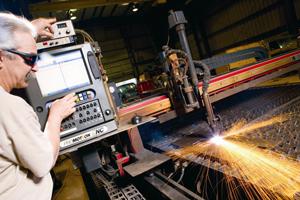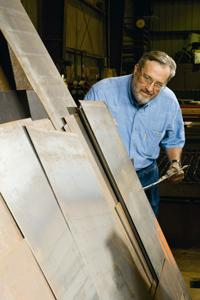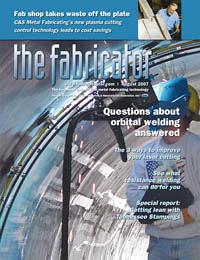- FMA
- The Fabricator
- FABTECH
- Canadian Metalworking
Categories
- Additive Manufacturing
- Aluminum Welding
- Arc Welding
- Assembly and Joining
- Automation and Robotics
- Bending and Forming
- Consumables
- Cutting and Weld Prep
- Electric Vehicles
- En Español
- Finishing
- Hydroforming
- Laser Cutting
- Laser Welding
- Machining
- Manufacturing Software
- Materials Handling
- Metals/Materials
- Oxyfuel Cutting
- Plasma Cutting
- Power Tools
- Punching and Other Holemaking
- Roll Forming
- Safety
- Sawing
- Shearing
- Shop Management
- Testing and Measuring
- Tube and Pipe Fabrication
- Tube and Pipe Production
- Waterjet Cutting
Industry Directory
Webcasts
Podcasts
FAB 40
Advertise
Subscribe
Account Login
Search
Taking waste off the plate
Operators for C&S Metal Fabricating use controller software to improve quality, reduce costs in thermal cutting
- August 8, 2007
- Article
- Plasma Cutting

George Conner, a C&S machine operator, nests plates and performs numerous other shape-cutting functions right at the cutting machine on the shop floor.
Many fabricating operations now use offline programming centers for parts design and plate nesting. In fact, many of those same companies use their offline centers to automate the metal cutting process. They simply download the part program nests from the front office to the shop floor, where PC-based controllers automatically start and stop the oxyfuel or plasma cutting process.
Fabricating, however, isn't always that simple. Houston-based C&S Metal Fabricating went against the trend of offline programming, and in doing so, the company is improving quality, increasing productivity, and saving money.
Bringing the Process In-House
C&S Metal Fabricating is a fabricator of parts for the oil and petrochemical industry, primarily serving customers within a 75-mile radius of Houston. Principal products include noncode vessels, tanks, and pressure piping; structural steel components; stacks, platforms and ladders; hoppers and bins; ductwork made from 16-gauge and heavier steel; pipe fabrications through 108 inches in diameter; fabricated concentric and eccentric reducers; and pipe supports. Customers such as Oil States Industries Inc., Siemens, and GB Biosciences use these fabrications in nearby plants and sometimes in installations in other parts of the world.
C&S Metal Fabricating starts the fabrication process with visual inspection of drawings and analysis of the customer's request. The company then designs individual shapes and one-of-a-kind subassemblies for the application. Most fabrications are made from carbon steel, stainless steel, or aluminum.
Despite its bending, machining, shearing, and welding expertise, C&S used to outsource all of its plate cutting needs to local steel service centers. That changed 31⁄2 years ago when the company decided it wanted more control of the plate cutting operation.
"Steel service centers could only guarantee us quality to plus or minus one-eighth of an inch," said C&S President S.F. "Chip" Holmesly Jr. "For the kind of specialized and sophisticated work we were getting and the kind of quality we needed to deliver, that simply was not good enough. And while steel service centers are set up for high-volume production, they do not always provide fast turnaround and quick response. We needed the type of high quality and immediacy that vendors simply could not deliver."
C&S purchased a Koike Plate Pro cutting machine in 2003 that included an oxyfuel torch and a plasma torch. The machine has a 10-foot cutting area between rails and a total cutting length of 40 ft. over two cutting beds, each with its own water supply. C&S now cuts carbon plate up to 8 in. thick on one bed and 11⁄4-in. stainless or aluminum on the other bed. Aluminum and stainless, of course, are never cut on the same table as carbon steel.
"It is too easy for carbon dust in the waterbed to blow up from the water and contaminate the bottom of the aluminum or stainless plate," Holmesly said.
The Operator Takes Control
Holmesly said one of the main reasons C&S purchased the Koike cutting machine was its PC-based iCNC® shape-cutting control from ProMotion Controls.
"To begin with, we liked the iCNC's graphic visual nesting and real-time viewing capability—the fact that you can see both what you are cutting and what you will be cutting next," he said.
The iCNC has two microprocessors, one for machine motion and the other for all machine interfaces and processes. This allows users such as C&S to see cutting activity and the upcoming nest simultaneously.
Holmesly also said he liked the fact that the new software allowed operators to rely on their experience and make shop floor decisions that could result in more efficient metal cutting. Much like other fabricators, C&S designs parts in AutoCAD®, converts them to DXF files, and then downloads them to the shape-cutting machine controller on the shop floor. That's where the similarity ends.
At C&S all nests are programmed on the shop floor. An operator can use the ProMotion nest software to nest shapes automatically to different sizes and configurations of plate and then manually move those parts around for even better material utilization.
"Instead of buying all standard plates, we now save anywhere from 10 percent to 30 percent by purchasing irregular remnants," Holmesly said.
C&S also better utilizes its own remnants.
"For instance, one product that we routinely fabricate requires us to cut large-diameter flanges. After each flange is cut, we drop a 3-foot-diameter plate. ProMotion nest software enables the operator to easily and automatically nest and cut those circular remnants or any remnant on-the-fly," Holmesly said.
Consequently, C&S has started a program of better material management. Operators are using the software to create scrap cutting lines on plate being cut. After a machine operator makes his nest, he draws a scrap cutting line. After all of the parts are cut, the machine automatically cuts the plate off at that line, removing the skeleton and creating another remnant to inventory and cut later.
George Conner, a C&S machine operator, has found other benefits.
"A bridging feature enables us to minimize the number of pierces, saving production time while prolonging the life of each torch tip," he said. "Using the bridging tool, I need to pierce the plate only once to cut a number of shapes, rather than piercing the steel each time I cut a shape. Considering the fact that each torch tip set might cost us $30 to $40, and that torch tip life is relatively short, we might be saving as much as 30 percent on our consumables."
The bridging tool also can be used to eliminate a secondary finishing operation. Conner said he often changes pierce point locations to areas where he knows there will be a weld, which will remove any evidence of the pierce.

Holmesly checks part of their plate remnant inventory. C&S now saves between 10 percent and 30 percent by purchasing irregular-shaped remnants.
By using the software's chain-cutting feature along with its lead-in and lead-out tool, Conner said he can link stainless and aluminum parts together, move them around as a group, then modify and shorten the lead-ins and lead-outs to clear slag.
Machine operators also have found new ways to use their new tools. Although C&S purchased the cutting machine primarily for cutting plate and sheet, operators soon figured out the table could be used to cut holes in 16-, 18-, and 20-in.-diameter pipe, as well as angle iron, beams, and channels.
A Cut Above
The cutting table and cutting software have emerged as important tools as C&S looks for more precision-cutting business. In fact, the company is frequently reminded that bringing 2-D shape cutting in-house was a good idea.
Just recently the company completed a job that required them to cut 60 tons of steel. Ironically enough, C&S chose to outsource all of the large, "easy" parts to another company to keep their own machine—which sometimes runs an entire eight-hour shift—from getting tied up. Unfortunately, C&S ended up having to reject 50 of the 360 parts cut because the outsourced parts simply did not meet their quality standards.
Over the last three years, C&S has raised its own quality standards regarding cutting tolerances. The company has a new standard of ±1⁄16 in., compared to ±1⁄8 in. before the new equipment arrived.
The types of orders and the types of parts the fabricator has been asked to cut and then fabricate have changed as well.
"It seems that customers have discovered our new shape-cutting machine and control capability almost as fast as we have discovered it ourselves. Today we are making higher-quality parts with closer tolerances than ever, products that we simply could not have made before," Holmesly said.
New parts mean new business opportunities. C&S expects to reach about $2 million in sales this year and hopes to double that in 2008.
Better Cutting, Better Business
With its new Koike Plate Pro shape-cutting machine and ProMotion iCNC controller, C&S Metal Fabricating is capable of fabricating higher-quality parts with closer tolerances than ever before. Consequently, the company continues to get orders for increasingly more sophisticated subassemblies.
In 2006 C&S made 110 transport shields and expects to make more than 200 in 2007. These sophisticated subassemblies are used for transporting nuclear radioactive source material inside a lead ball. Prior to fabrication, each unit is plasma-cut from 5⁄8-inch stainless steel plate.
Related Companies
subscribe now

The Fabricator is North America's leading magazine for the metal forming and fabricating industry. The magazine delivers the news, technical articles, and case histories that enable fabricators to do their jobs more efficiently. The Fabricator has served the industry since 1970.
start your free subscription- Stay connected from anywhere

Easily access valuable industry resources now with full access to the digital edition of The Fabricator.

Easily access valuable industry resources now with full access to the digital edition of The Welder.

Easily access valuable industry resources now with full access to the digital edition of The Tube and Pipe Journal.
- Podcasting
- Podcast:
- The Fabricator Podcast
- Published:
- 04/16/2024
- Running Time:
- 63:29
In this episode of The Fabricator Podcast, Caleb Chamberlain, co-founder and CEO of OSH Cut, discusses his company’s...
- Trending Articles
AI, machine learning, and the future of metal fabrication

Employee ownership: The best way to ensure engagement

Steel industry reacts to Nucor’s new weekly published HRC price

Dynamic Metal blossoms with each passing year

Metal fabrication management: A guide for new supervisors

- Industry Events
16th Annual Safety Conference
- April 30 - May 1, 2024
- Elgin,
Pipe and Tube Conference
- May 21 - 22, 2024
- Omaha, NE
World-Class Roll Forming Workshop
- June 5 - 6, 2024
- Louisville, KY
Advanced Laser Application Workshop
- June 25 - 27, 2024
- Novi, MI



























